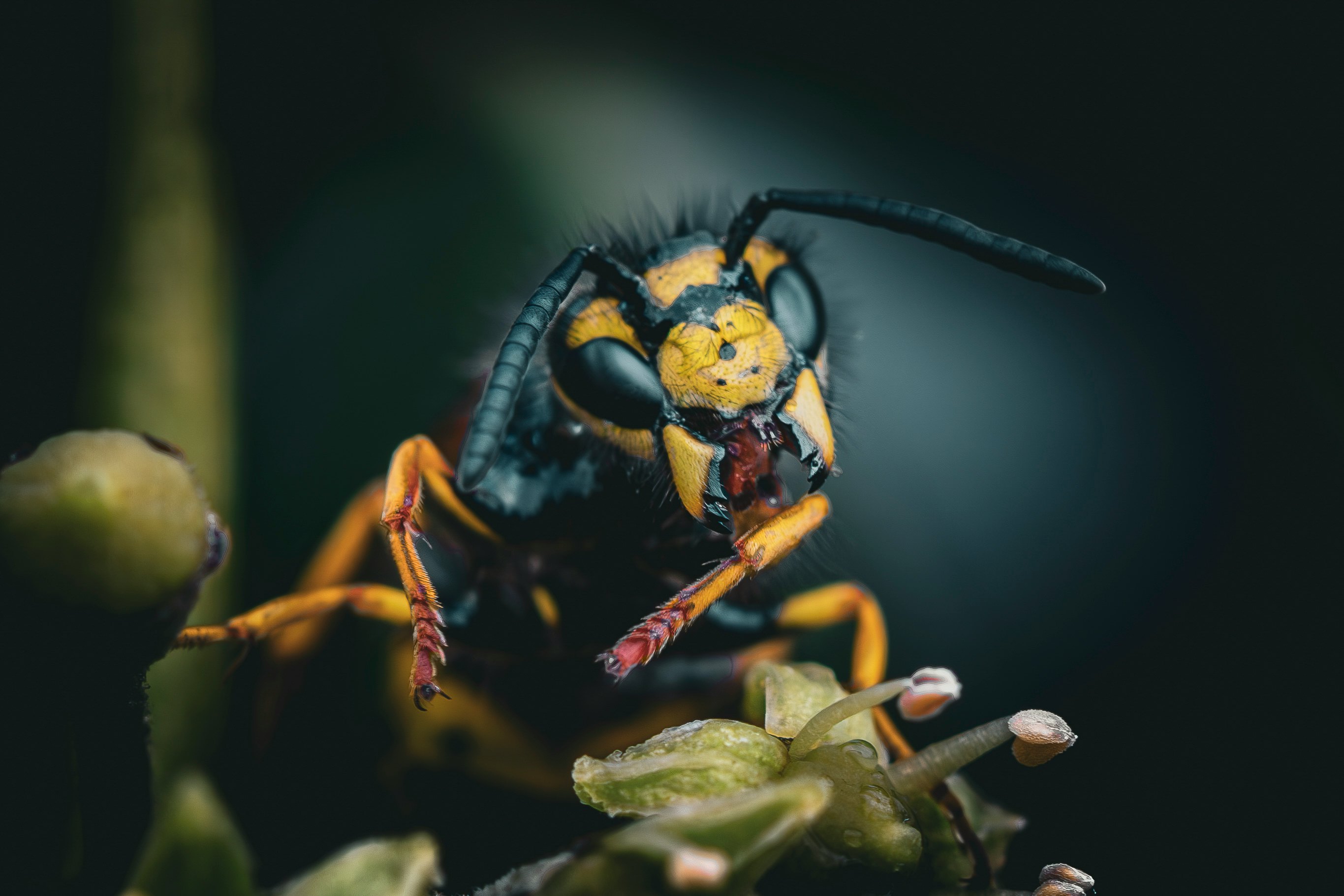
If you puncture the ovary of a wasp called Microplitis demolitor, viruses squirt out in vast quantities, shimmering like iridescent blue toothpaste. “It’s very beautiful and just amazing that there’s so much virus made in there,” says Gaelen Burke, an entomologist at the University of Georgia.
M. demolitor is a parasite that lays its eggs in caterpillars, and the particles in its ovaries are “domesticated” viruses that have been tuned to persist harmlessly in wasps and serve their purposes. The virus particles are injected into the caterpillar through the wasp’s stinger, along with the wasp’s own eggs. The viruses then dump their contents into the caterpillar’s cells, delivering genes that are unlike those in a normal virus. Those genes suppress the caterpillar’s immune system and control its development, turning it into a harmless nursery for the wasp’s young.
The insect world is full of species of parasitic wasps that spend their infancy eating other insects alive. And for reasons that scientists don’t fully understand, they have repeatedly adopted and tamed wild, disease-causing viruses and turned them into biological weapons. Half a dozen examples already are described, and new research hints at many more.
By studying viruses at different stages of domestication, researchers today are untangling how the process unfolds.
Partners in diversification
The quintessential example of a wasp-domesticated virus involves a group called the bracoviruses, which are thought to be descended from a virus that infected a wasp, or its caterpillar host, about 100 million years ago. That ancient virus spliced its DNA into the genome of the wasp. From then on, it was part of the wasp, passed on to each new generation.
Over time, the wasps diversified into new species, and their viruses diversified with them. Bracoviruses are now found in some 50,000 wasp species, including M. demolitor. Other domesticated viruses are descended from different wild viruses that entered wasp genomes at various times.
“Some people say that it’s definitely still a virus; others say it’s integrated, and so it’s part of the wasp.”
Researchers debate whether domesticated viruses should be called viruses at all. “Some people say that it’s definitely still a virus; others say it’s integrated, and so it’s part of the wasp,” says Marcel Dicke, an ecologist at Wageningen University in the Netherlands who described how domesticated viruses indirectly affect plants and other organisms in a 2020 paper in the Annual Review of Entomology.
As the wasp-virus composite evolves, the virus genome becomes scattered through the wasp’s DNA. Some genes decay, but a core set is preserved — those essential for making the original virus’s infectious particles. “The parts are all in these different locations in the wasp genome. But they still can talk to each other. And they still make products that cooperate with each other to make virus particles,” says Michael Strand, an entomologist at the University of Georgia. But instead of containing a complete viral genome, as a wild virus would, domesticated virus particles serve as delivery vehicles for the wasp’s weapons.
Those weapons vary widely. Some are proteins, while others are genes on short segments of DNA. Most bear little resemblance to anything found in wasps or viruses, so it’s unclear where they originated. And they are constantly changing, locked in evolutionary arms races with the defenses of the caterpillars or other hosts.
In many cases, researchers have yet to discover even what the genes and proteins do inside the wasps’ hosts or prove that they function as weapons. But they have untangled some details.
For example, M. demolitor wasps use bracoviruses to deliver a gene called glc1.8 into the immune cells of moth caterpillars. The glc1.8 gene causes the infected immune cells to produce mucus that prevents them from sticking to the wasp’s eggs. Other genes in M. demolitor’s bracoviruses force immune cells to kill themselves, while still others prevent caterpillars from smothering parasites in sheaths of melanin.
The wasps keep control
Virus-taming is likely a dangerous endeavor. After all, the wild relatives of domesticated viruses can be deadly, commandeering cells to produce viral particles and then to burst, releasing their contents. Some of them make the innards of insects dissolve into goop. In fact, even in the domesticated situation, sometimes specialized cells in wasp ovaries must burst in order to release viral particles.
“The wasp has to find a way to control that virus so that it’s not infecting and killing the wasp itself,” says Kelsey Coffman, an entomologist at the University of Tennessee.
How have wasps evolved to control their pet viruses? Most important, they’ve neutered them. The virus particles can’t reproduce because they don’t contain the genes that are crucial to building new virus particles. Those remain in the wasp genome.
Wasps also control where and when the domesticated virus particles are produced, presumably to reduce the risk of the virus going rogue. Bracovirus particles are made only in one pocket of the female’s reproductive tract and only for a limited time.
And key virus genes have been lost altogether such that the domesticated viruses cannot replicate their own DNA. This loss is seen even in recently domesticated viruses, suggesting that it’s an important first step.
In fact, any viral genes that don’t help the wasp will gradually accumulate mutations. In bracoviruses, so much time has passed that the unused genes are unrecognizable. In viruses domesticated more recently, the remnants can still be identified.
A ‘missing link’ revealed
There’s nothing special about having a genome full of dead viruses. Viruses jump into animal genomes all the time; even our own DNA is littered with their remains. However, only parasitic wasps are known to maintain whole sets of genes that still work together to build viral particles.
Researchers are eager to understand how these relationships start. For clues, some are turning to a little orange wasp called Diachasmimorpha longicaudata, which may be in the early stages of domesticating a poxvirus. The poxvirus is not a true domesticated virus because its DNA hasn’t entered the wasp’s genome. Instead, it replicates on its own in the wasp’s venom glands.
Like other virus-taming wasps, D. longicaudata injects viral particles into its host, which in this case is a fruit fly maggot. Coffman and Burke, with researcher Taylor Harrell, have shown that without the poxvirus, most of the wasp larvae die. But unlike fully domesticated viruses, the poxvirus also replicates outside the wasp, producing new virus particles in the maggot’s cells. The wasp benefits from the poxvirus, but she doesn’t fully control it.
This weak control could reflect the type of virus the wasps started with, says Coffman. Most domesticated viruses are descended from types of viruses called nudiviruses, which can integrate into wasp genomes more easily than poxviruses.
But it’s also possible the wasps just haven’t had enough time yet. Indeed, the wasp-poxvirus partnership is so new it appears to be present in only one species of wasp. It’s even missing from another species that is so similar that Coffman didn’t at first realize she had both wasps in her lab.
Still, the virus is isolated to certain tissues and only replicates when eggs are developing, which could mean that D. longicaudata has already established some defenses. The viruses also seem to be losing their ability to be transmitted without the wasp’s help. “I’ve tried feeding the flies with a lot of virus and they don’t seem to get infected that way,” Coffman says.
The poxvirus system is exciting, adds Coffman, because so little is known about how virus domestication begins. “We can’t go back in time and know how it started. But with this system — it’s new. We’ve got this snapshot of, you could say, the missing link.”
Though no one knows for sure why virus domestication keeps happening in parasitic wasps, researchers suspect it’s related to their lifestyle. Internal parasites live in their hosts’ innards, hazardous environments that are actively trying to kill them. From a wasp’s perspective, viruses are like packages loaded with tools for solving this most dire problem.
Support for this idea comes from 2023 research looking at the genomes of more than 120 species of wasps, ants, and bees. The researchers scoured these genomes for signs of the types of viruses that tend to become domesticated. They inferred the presence of domesticated viruses by detecting virus genes that have been kept in a functional state over evolutionary time. Such preservation would not be expected unless the genes were helping the wasps to survive or reproduce.
As expected, non-parasitic insects showed little evidence of having these domesticated viruses. The same was true of parasites that develop on the outsides of their hosts’ bodies, where the host's immune system can’t get at them. However, in the parasites that develop inside other insects — called endoparasitoids — domesticated viruses appeared to be far more common.
“There is a special connection between viruses and these endoparasitoids,” says Julien Varaldi, an evolutionary biologist at Claude Bernard University Lyon 1 in France and one of the study’s authors. “It’s suggesting that those viruses do play an important role in the evolution of this way of life.”
And with hundreds of thousands of wasp species and uncountable strains of viruses, there are ample chances for the two entities to team up. It is, Strand says, “an evolutionary sandbox of opportunity.”
This article originally appeared in Knowable Magazine, an independent journalistic endeavor from Annual Reviews. Sign up for the newsletter.







